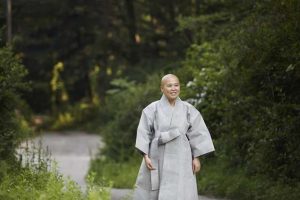Bhikkhuni Dhammadinna presents a rigorous, historical-critical case for transcending sectarian boundaries within and across Buddhist traditions while treasuring our inheritance from the ancient past. The first in a series of conversations.

Non-sectarianism is one of those terms that Buddhist institutions like to invoke at festivals and conferences. Overused though it might be, practicing non-sectarianism requires open leadership balanced with intellectual rigor. To embody this principle means to nudge Buddhist communities toward embracing cooperation and solidarity, while making a case for why old biases can be discarded without losing ground on maintaining tradition.
One of the best people to make the case for an informed approach to non-sectarianism is Bhikkhuni Dhammadinna, whose specialty is in the Pali, Sanskrit, and Tibetan Agamas among others. In Bhikkhuni Dhammadinna’s own life and path as a monastic and an academic, she has encountered all manner of intersections between heartfelt belonging to living Buddhist communities and dogmatic approaches (alongside their affective and existential resonances, all the way from doctrinal fundamentalism to power abuse).
One example is her own identity as a Theravada bhikkhuni. While visiting Taipei, I had the opportunity to have a comprehensive conversation with her on how our cutting-edge scholarship on the history of the female monastic order and its contemporary revival can contribute to supporting non-sectarianism.
“The term ‘Theravada’ denotes really only one thing: the monastic lineage that is dominant in South Asia and Southeast Asia, and its living cultures in history―to which we need to add Theravada in its Western reception and transformations,” Bhikkhuni Dhammadinna says. “Mahayana and Vajrayana do not reflect lineages, but rather doctrinal stances that became dominant in East Asia, Inner Asia, and the Himalayan region.” She further notes that the real equivalent of “Theravada,” in the strictest sense, would actually be Dharmaguptaka and Mulasarvastivada, the ordination lineages adhered to by non-Theravada monastics, stressing: “These lineages as such, technically speaking, say nothing about beliefs.”
Her core point here is that it is not impossible to live according to the rules and regulations of Theravada monastics while upholding the bodhisattva ideal, which is typically seen as Mahayana. The bodhisattva ideal is certainly well-documented in Theravada scriptures, and influential Theravada teachers in contemporary times are known to have intentionally embraced the bodhisattva path. Bhikkhuni Dhammadinna highlights several figures, including the late Ven. Balangoda Ananda Maitreya (1896–1998) and Ven. Nauyane Ariyadhamma Mahathera (1939–2016) in Sri Lanka, to illustrate her example.
To delve deeper into non-sectarianism from a historical perspective, one needs to go back to the beginning of the Buddhist tradition itself—or at least our closest approximation of it. Ven. Dhammadinna says: “We have no way of accessing what the Buddha said, his exact words. The possibility of that verbatim knowledge slipped over our historical horizon long ago. The institutional container of the Theravada, for example, which oversaw the transmission of [one of] the corpora of the Buddhist order’s early teachings [in the form of the Pali Canon], can justifiably claim to be one of the legitimate monastic lineages that have passed down, and are the heir to the initial delivery of the Buddha’s teachings.”
Theravada can also claim to be the holders of the only body of the early teachings of the Buddha surviving in complete form, through its Nikayas and its Vinaya, and stemming from a single tradition of oral transmission. As Bhikkhuni Dhammadinna notes: “The Chinese Agamas, for example, are an assemblage of texts stemming from different lineages of transmission, different institutional containers that oversaw their recitation and maintenance.”
Ven. Dhammadinna points out that this is purely through historical accident, thanks to Theravada originating in India and being transmitted to places such as Sri Lanka. She contrasts this situation with China’s example, where Dharmaguptaka, Sarvastivada, and other monastic lineages had their texts (Agamas and Vinayas) filtered into the region piecemeal, and where the early Buddhist scriptural body was instead formed as a historical construct outside of India.
“When we speak of the early Buddhist teachings, we have intrinsically multiple primary sources, which are the end result of multiple lineages of transmission, which were spread out across India and beyond Indi,” Ven. Dhammadinna explains. “This means that the orally delivered, formalized, and transmitted teachings gradually and perhaps inevitably started to differ in subtle ways between the monastic communities that were spreading across India. At some point, these communities of recitation became so far apart that they were no longer transmitting the same text verbatim. This was due to a practical reason: in such an oral culture, you would no longer be reciting the same text.”
Ven. Dhammadinna continues: “When such divergences occur, these nascent communities become the forerunners of the different monastic institutions, of which there were many in ancient India and medieval Asia. This would eventually become what we know as the Theravada, Sarvastivada, and so on.” She identifies that at this historical point, it already seems erroneous to speak of “Buddhist sects” or sectarianism. What some scholars once thought were “schisms” were really organic diversifications of institutional units. Nevertheless, at some point, identification with one’s own—by now diversified—monastic group forms the basis for the emergence fully-fledged sectarianism.
A common academic projection is the word “council” on what is called sangiti, the communal recitals of the canonical texts within a given monastic community. These sangitis no doubt began to transmit different versions of past iterations as time went on and their reciters spread across India, Sri Lanka, and Central Asia, before new simas (boundaries that are established for a monastery to be built) were established in non-Indic regions such as China and Tibet. There was never really a doctrinal schism to speak of in the early days of the monastic community, certainly not like the epoch-making, church-splitting schisms that rocked Catholic, Orthodox, and Protestant Christianity.
There is a specific way in which the Theravada perceives itself, and this self-understanding can distort what should be an openness to understanding the teachings of fellow Buddhists. Ven. Dhammadinna notes: “Theravadins, like all people, can have bias too. Take, for example, how Sri Lankans were exposed to Japanese Buddhist priests before independence and got this idea that the Japanese sangha was corrupted, married clergy, defying the rule of celibacy. These perceptions arose on being exposed to the contemporary Japanese Buddhist clergy in the absence of knowledge, let alone historical understanding, of the events and consequences of the Meiji Restoration in Japan, which had sanctioned the disbandment of the celibate monastic institution and enforced marriage etc. Through historical analysis we understand how certain biases and labels arise. For Theravadins to consider Mahayanists as a block is an oversimplification, as we discussed earlier.”
At the same time, however, Bhikkhuni Dhammadinna’s proposal is not to discard or fundamentally change the traditional Buddhist paradigms and traditional construction of the historical discourse. “I especially need to emphasize this: just because our generation in the present historical situation is able to acquire a more sensitive and historically-informed understanding of the development of the Buddhist traditions, this does not mean we should look down on ‘traditional’ Buddhists as agents and subjects of history by way of some sort of post-modern conceit. It is these traditional paradigms that gave us the religious tradition as it is now, which includes their universal value side by side with its time-bound characteristics.”
Rather, she hopes to see scholarship (a world with which she has become familiar) working in tandem with Buddhist leaders and communities to make spiritual identities subject to self-reflection and an understanding of the conditioned arising of these very same identities; while also maintaining insightful and productive conversations about the valid methods all schools have developed for the purpose of freedom and awakening.
“It would be sad to see an ultimately sectarian, and/or fundamentalist hardening of self-identity in light of the most updated scholarly findings. But I believe that this backlash can be avoided as long as our lineages accord the appropriate respect to one another. Whatever our path, what we share is an ethical grounding in the Vinayas as we have received them—the Theravada, the Dharmaguptaka, and the Mulasarvastivada—and in Buddhist ethical principles at large. Origins aside, I am more concerned that we do our utmost to live up to these codes with integrity and authenticity.”
Related features from BDG
A Sangha for Peace and Inclusivity: Intersectionality in Gender Work in Japan
Buddhistdoor View: New Theravada Bhikkhuni Ordinations a Cause for Joy
How I Became a Theravada Buddhist
Related blog posts from BDG Tea House
New findings on the Buddhist Oasis Kingdom in “Siddham, Studies in Iranian philology in honour of Mauro Maggi”
The TLKY International Conference 2021 Interview Series – Ven. Bhikkhuni Dhammadinna












